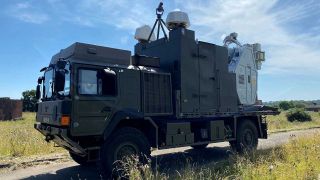The UK’s Ministry of Defence has announced successful trials of a “game-changing weapon that can take down a swarm of drones using radio waves.” The new vehicle-mounted Radio Frequency Directed Energy Weapon (RFDEW) can devastate a wave of drones from up to a kilometer away (about 1,094 yards) at a cost of only about 10p (13 cents) per downed device.
With this news release so close to Christmas, the MoD quipped that the RFDEW could take down a drone swarm “for less than the cost of a pack of mince pies.” These are an unusual seasonal sweet treat packed with fruit, spices, and suet, sold in the British Isles at this time of year.
Last week, we covered the news that the British Army had successfully tested a Wolfhound high-energy laser weapon system (HELWS). That drone elimination weapon leveraged a high-energy laser to sense and track enemy drones, concentrating a laser beam on them until they were destroyed. The HELWS was said to have been a great success in the trials.

Though the laser-based HELWS system was said to be 100% effective in trials, its description provoked questions about its drone-killing capacity. In other words, and as Tom’s Hardware readers highlighted, what if there’s a drone swarm to deal with? Hopefully, the RFDEW answers those real concerns with its completely different drone-neutralizing tech.
The MoD press release explains that “the weapon uses high-frequency waves to disrupt or damage critical electronic components inside devices such as drones, causing them to be immobilized or fall out of the sky.” It also claims that RFDEW can be effective against land—or sea-based drones. Like the HELWS, the RFDEW was tested at a range in West Wales.
We’ve already mentioned the low cost per enemy drone downed touted for the RFDEW. It is also thrifty about human labor. The system is highly automated and requires only a single operator, says the MoD. Moreover, it is flexible in terms of deployment and easily mounted onto a military vehicle, as pictured.
We’ve seen the war in Ukraine emerge as one where drones have become a major force for both sides. Ukrainian drone makers have even been using ChatGPT to optimize drone bomb designs. Drones have also been disrupted outside of war zones, so authorities having access to equipment adept at dealing with either individual or swarms of drones has become increasingly important worldwide. With this in mind, it is good to see the UK developing and successfully testing a range of anti-drone measures, which allies could share.

 14 hours ago
2
14 hours ago
2








 English (US) ·
English (US) ·